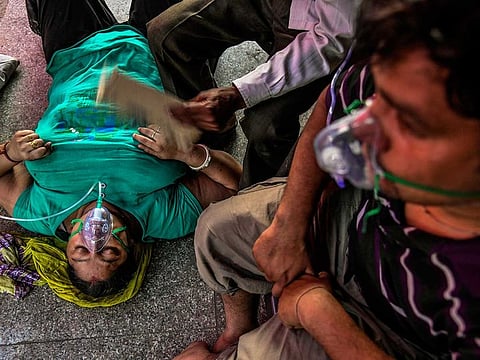Second wave: Pseudoscience behind India’s COVID-19 crisis
Data on coronavirus infections and deaths has not guided government’s policy and politics

Since the beginning of April 2021, India is witnessing a sharp spike in new Covid-19 cases, which has brought unimaginable public health emergencies. Thousands are dying, and the confirmed new cases have gone up to 400,000 daily.
The images of mass cremation pyres and desperate struggle of the COVID-19 patients in front of hospitals for a bed and oxygen, even in India’s capital city Delhi have exposed India’s lack of prior preparedness to meet easily predictable second wave.
India’s Covid crisis has become so huge that it has brought unthinkable misery for the country and has posed a serious threat to the world. India’s highly contagious double mutant (officially called B. 1.617) has already spread to at least 17 other countries, and the others are worried about being affected by it. The US has banned travels from India, and Australia threatens a 5-year jail term for anyone arriving from India.
A devastating crisis
It is essential to ask why India’s COVID crisis has become so devastating. No doubt that the country was not prepared to face the second wave despite having at least more than a year of notice. Three countries in the world, which have faced the wrath of the pandemic the most are the Trump-era US, Brazil, and India.
Besides the common factor of governance under the right-wing populist governments, the other common link between these three countries is ignoring science and data and instead of glorifying popular beliefs.
India’s seriously troubling relationship with science and data has not started with the COVID-19 pandemic, but it is at least a seven-year-old phenomenon. Immediately after coming to power in 2014, the leader of the new government made sensational claims that cosmetic surgery and genetic science existed in India thousands of years ago.
The open patronage of Vedic Science and promotion of ‘voodoo’ medicines has undermined scientific and medical research and brought serious difficulties for scientists and medical practitioners within the country.
In the plan to boost a newfound pride, pseudoscience is being promoted for the last seven years, which has helped to strengthen the ruling party’s vote bank. But, it has caused the most damage to India’s ability and preparedness to fight the coronavirus and contain the severity of the pandemic-induced public health emergency.
Several ruling party leaders and ministers openly and publicly claimed that cow urine could help cure coronavirus. Two weeks ago, the Chief Minister of Uttarakhand allowed millions of devotees to take a dip in the Ganges water, which he described as ‘Maa Ganga’s blessing in flow’.
False claims galore
India’s Water Ministry wanted doctors to find out if Gangajal can cure COVID. India’s AYUSH Ministry asked people to drink hot milk with turmeric as part of the COVID protocol. The minister himself made a false claim that the Prince of Wales had recovered from COVID using ‘ayurvedic medicine’.
Another minister even claimed an Indian snack, papad, can boost antibodies against coronavirus. Even India’s health minister publicly promoted an Ayurvedic medicine ‘Coronil’ for COVID-19 treatment in February 2021 while the company producing it falsely claimed the medicine was WHO-certified.
These claims are no less bizarre than Trump’s suggestion that disinfectant could be used to treat the virus or Bolsonaro’s public display of gulping down hydroxychloroquine tablets. However, some of the claims being made in India are inexplicable, and the decision of the leadership to declare a 14-hours of lockdown (Janata Curfew) in March 2020, then claiming that they can defeat the coronavirus in 21 days, confused the people more.
Mass clapping, banging pots and other gobbledygook
The nation was goaded using astrology and Vedic science to mass clapping, banging utensils, and lighting candles during the first wave.
India was promoting pseudoscience and did many things to undermine good science in its battle against coronavirus. Like any other scientific discipline, the advancement of medical science depends upon a strong foundation of credible data. India’s data on COVID infection and death have not guided the government’s policy and politics; rather its policy and politics have guided what the data should look like.
Systemic undercounting of COVID casualty and masking critical information helped authorities declare premature victory against the virus and engage in ‘vaccine diplomacy’ but this has seriously affected the country’s scientific approach to public health response.
The double mutant was first detected in India in the first week of October 2020, but India’s health ministry confirmed it only 24 March 2021. The country took almost one year to put a centralised genome sequencing mechanism in place, and that has even failed to perform correctly due to lack of good data.
If the data would have properly collected and followed through, and the advice of public health experts listened to, in that case, it is very difficult to imagine the country allowing large political meetings in the states like West Bengal and religious gatherings at the bank of the Ganges River while it was on the verge of a devastating phase of the second wave.
Pseudoscience and manipulation of data might keep the followers of right-wing populists happy and gloated but seriously harm a country’s public health at the time of a pandemic.
Belief in the importance of science and pursuing policies based on good data would not have stopped the second wave of the COVID-19 pandemic, but it would have certainly prepared India and its hospitals better and saved thousands of lives.
Sign up for the Daily Briefing
Get the latest news and updates straight to your inbox









